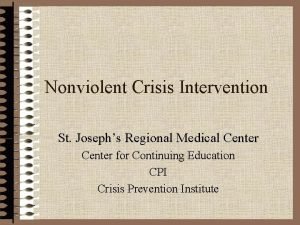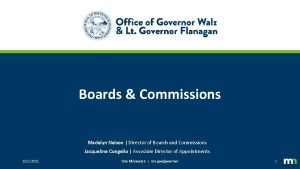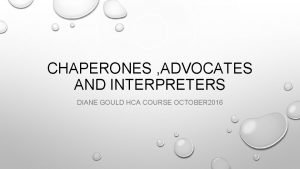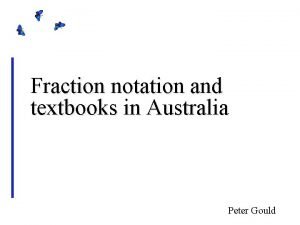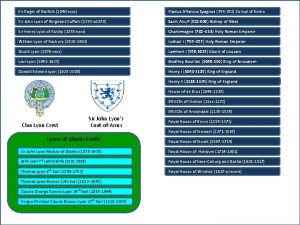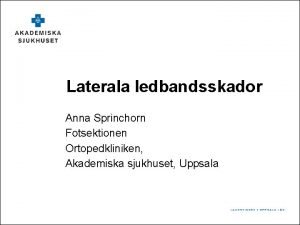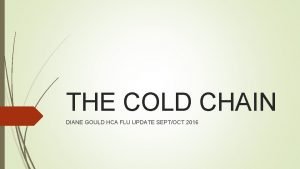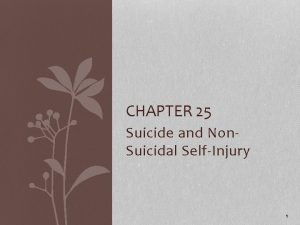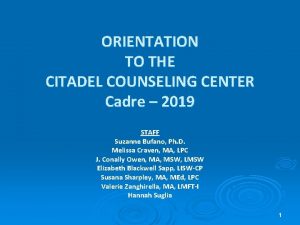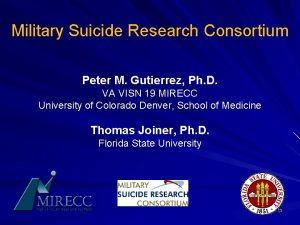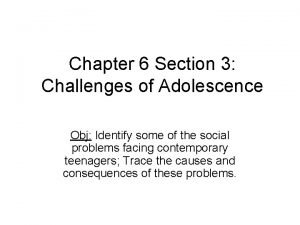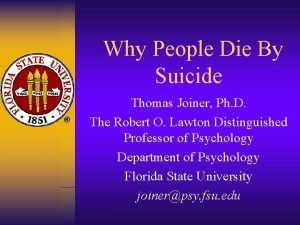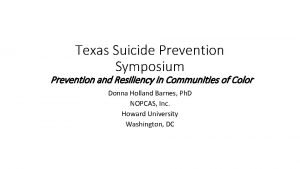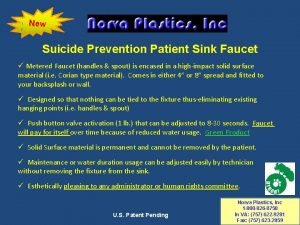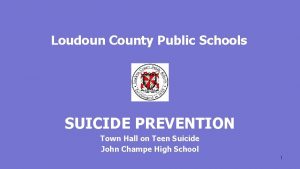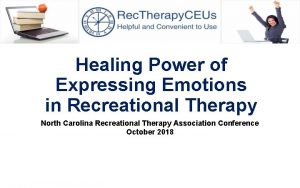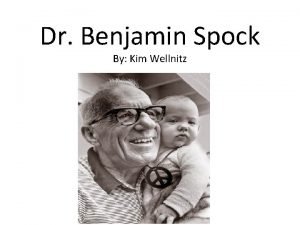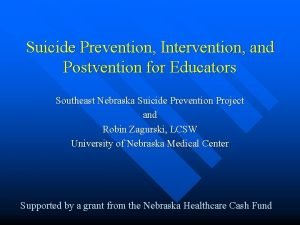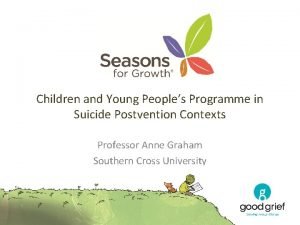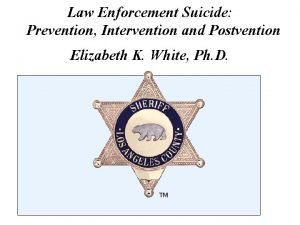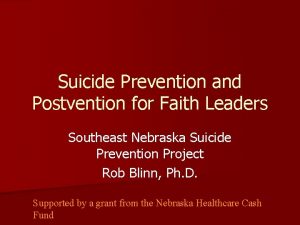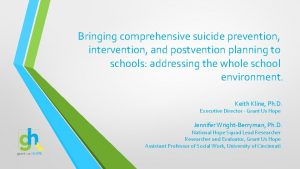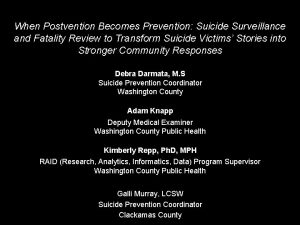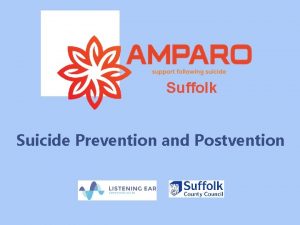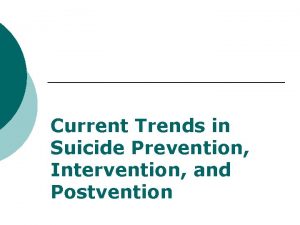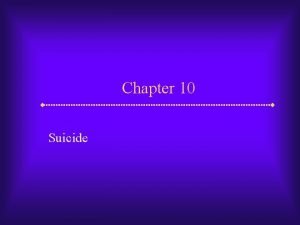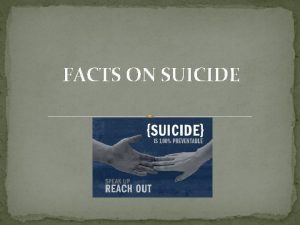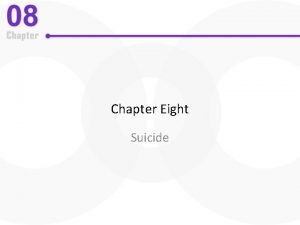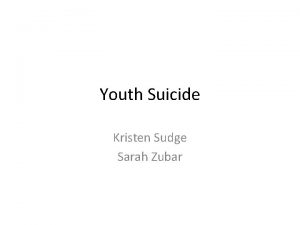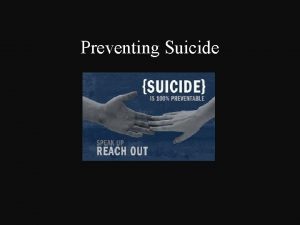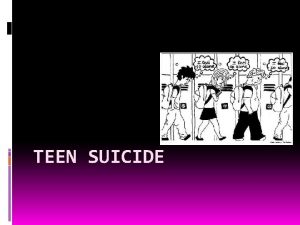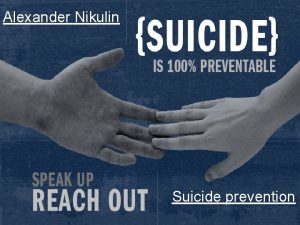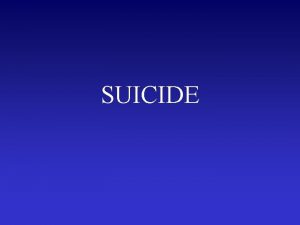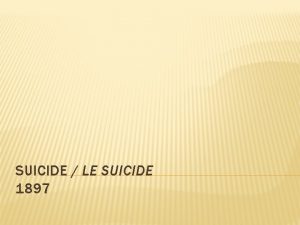Suicide Clusters and Postvention Madelyn S Gould Ph































- Slides: 31

Suicide Clusters and Postvention Madelyn S. Gould, Ph. D. , M. P. H. Professor of Epidemiology in Psychiatry Columbia University/New York State Psychiatric Institute New York State Suicide Prevention Conference Albany, NY September 13, 2016

2 SUICIDE CLUSTERS: WHAT WE KNOW Suicides can cluster in: • time only (temporal or “mass” clusters) • space only (spatial or geographic clusters) • space and time (space-time or “point” clusters)

3 SUICIDE CLUSTERS: WHAT WE KNOW There is no one type of “suicide cluster-prone” community. Clusters occur in communities with varying socioeconomic and ethnic profiles.

4 SUICIDE CLUSTERS: WHAT WE KNOW Suicide clusters occur primarily among teenagers and young adults

5 SUICIDE CLUSTERS: WHAT WE KNOW 1988 -1996, 53 clusters

6 SUICIDE CLUSTERS: WHAT WE KNOW • At a minimum, 5 youth suicide clusters occur each year in the U. S.

7 SUICIDE CLUSTERS: WHAT WE KNOW The media can play a role in triggering a cluster

8 SUICIDE CLUSTERS: WHAT WE KNOW Stories published after the index cluster suicides compared to those published after non-cluster suicides: number of stories about any suicidal individual number of stories about the teen suicide in our study front page story placement, size of headlines, headlines containing the word suicide headlines containing a description of the methods sensational headlines presence of picture detailed descriptions of the suicidal individual and act

9 SUICIDE CLUSTERS: WHAT WE DON’T KNOW The precise mechanisms causing and sustaining a cluster are currently unknown. But………

10 SUICIDE CLUSTERS: WHAT WE THINK WE KNOW -Hypothesized Mechanisms • Social learning theory • Approach/Avoidance conflict: restraint reduction • “Social multiplier” that amplifies the effects of other suicidogenic factors • Changes in social norms

11 SUICIDE CLUSTERS: WHAT WE THINK WE KNOW Social Norms - Definition: • Implicit rules about “normal” or typical behaviors or beliefs in a group or setting – Concept in various behavioral theories (e. g. , Social Cognitive Theory, Theory of Planned Behavior) • Two main types: – What most people do (descriptive norms) – What most people approve of (injunctive norms) (Borsari and Carey, 2003; Rimal and Real, 2003; Smith and Louis, 2008)

12 SUICIDE CLUSTERS: WHAT WE THINK WE KNOW Social Norms • Research on other health issues finds – Perceived norms (descriptive and/or injunctive) are one predictor of behavior. • Media narratives and social norms – Narratives may convey or reinforce inaccurate perceptions about suicidal behavior, coping, services, offering help (adapted from Linda Langford, Sc. D. Suicide Prevention Resource Center)

13 SUICIDE CLUSTERS: WHAT WE THINK WE KNOW Social Norms

14 SUICIDE CLUSTERS: WHAT WE DON’T KNOW Postvention protocols to stop a suicide cluster have not been empirically evaluated. But………

15 SUICIDE CLUSTERS: WHAT WE THINK WE KNOW -Postvention strategies are suggested by other areas of research and clinical best practices-

16 SUICIDE CLUSTERS: WHAT WE THINK WE KNOW Best practices include… • Promoting media and public relations best practices • Assessing community risk • Initiating/promoting telephone and online crisis interventions and other technologies (e. g. , Apps) • Enhancing community connectedness • Shaping community members’ (including students’) desire to “do something” • Addressing myths and misinformation

17 Postvention Recommendations: I. Promoting media and public relations best practices: Adhering to media guidelines in the wake of a suicide

18 “…depression is treatable, and suicide is preventable. Don’t lose hope. You’re not alone. I, too, once firmly believed that I was broken beyond repair – but I was wrong. ”

Postvention Recommendations: 19 I. Promoting media and public relations best practices: Working with the media – changing narratives ü Build long-term relationships with reporters, editorial boards ü Teachable moments – e. g. , send out press releases on local prevention efforts ü Pitch story angles that change the focus/narrative ü Identify local experts who can provide information and who they can quote (and who can guide the narrative you want to achieve)

20 Postvention Recommendations: I. Promoting media and public relations best practices: Communicating about the deaths(s) ü Who will communicate about the death(s) to the community? How? ü What if the family doesn’t want to publicly acknowledge it is a suicide death? ü Who should communicate with the media?

21 Postvention Recommendations: II. Assessing community risk • Consider implementing AFSP’s online Interactive Screening Program (ISP) (http: //www. afsp. org/the-interactive-screening-program)

22 Postvention Recommendations: III. Initiating/promoting telephone and online crisis interventions, and other technologies (e. g. , APPS) • Promote Lifeline (1 -800 -273 -TALK) and Crisis Text Line (Text Go to 741741) • Responsible postvention initiatives should utilize social networking sites to 1) distribute relevant information and resources, and 2) monitor comments from individuals connected to the bereaved. (http: //www. sprc. org/library/Lifeline. Online. Postvention. Manual. pdf)

23 Postvention Recommendations: III. Initiating/promoting telephone and online crisis interventions, and other technologies (e. g. , APPS) (continued) • Work with families of the deceased to bypass any privacy settings that would prohibit online postvention activities • Find Social Media Profiles and Messaging: The first step is to determine if and where the recent suicide death is being discussed online. This will involve Facebook, Twitter, Instagram etc. • Post Resources: Once the deceased’s profile has been identified and accessed, the next step is to post resources in the comments section of the social media profile or on the profile itself.

24 Postvention Recommendations: III. Initiating/promoting telephone and online crisis interventions, and other technologies (e. g. , APPS): Social Media Resources Adapted from Kerri Smith, SPRC

25 Postvention Recommendations: III. Initiating/promoting telephone and online crisis interventions, and other technologies (e. g. , Apps): App Tools Virtual Hope Box by National Center for Telehealth & Technology (Apple App Store or Google Play)

26 Postvention Recommendations: III. Initiating/promoting telephone and online crisis interventions, and other technologies (e. g. , Apps): App Tools • MY 3 Suicide Prevention App (download at suicidepreventionlifeline. org or Apple App Store or Google Play)

27 Postvention Recommendations: III. Initiating/promoting telephone and online crisis interventions, and other technologies (e. g. , Apps): App Tools The Safety Plan App The Safety Plan app was developed with permission from Stanley & Brown (2012). Developers: Barbara Stanley, Gregory K. Brown, and Padraic Doyle. New York State Office of Mental Health.

28 Postvention Recommendations: IV. Enhancing community connectedness • Develop infrastructure for community collaboration • Include local government agencies, schools, universities, law enforcement and fire and emergency medical services, mental health and public health agencies, businesses, workplaces, faith communities and religious institutions, funeral professionals, social media and online communities, loss and attempt survivors, researchers • Facilitate the public’s access to community officials, e. g. , town hall meetings • Implement programs, such as Sources of Strength, designed to enhance connectedness

29 Postvention Recommendations: V. Shape community’s and students’ desire to “do something” • Need to balance needs of mourners, while minimizing likelihood of contagion • Encourage stories of resilience and help seeking for media outlets, including school papers • Encourage volunteering at nearest Lifeline crisis center (rather than starting a new crisis line) • Encourage participating in AFSP’s “Out of Darkness” walks

30 Postvention Recommendations: VI. Address myths and misinformation

31 Suicide Prevention Best suicide prevention involves a comprehensive continuum of activities: Gatekeeper Trainings Health promotion – Prevention – Intervention - Postvention Health promotion Prevention Intervention Postvention Adapted from Walrath et al, 2014
 Cpi postvention is used for
Cpi postvention is used for Comparative and superlative de colorful
Comparative and superlative de colorful Kaleb rumicho
Kaleb rumicho Hunter's seven steps of lesson planning
Hunter's seven steps of lesson planning Robert gould augsburg
Robert gould augsburg Jay gould childhood
Jay gould childhood Gospel of wealth apush definition
Gospel of wealth apush definition Goggletranslate
Goggletranslate Jay gould achievements
Jay gould achievements Which is larger
Which is larger Abigail gould
Abigail gould Draglådetest
Draglådetest Flu
Flu The sad persons scale
The sad persons scale Suicide girls colombia
Suicide girls colombia Mad acronym suicide prevention
Mad acronym suicide prevention The citadel counseling center
The citadel counseling center Youth suicide research consortium
Youth suicide research consortium Rvguev suicide
Rvguev suicide Food poison icd 10
Food poison icd 10 Chapter 5 lesson 3 health
Chapter 5 lesson 3 health Egoistic suicide
Egoistic suicide Suicide cuts across all social categories
Suicide cuts across all social categories Why people die by suicide joiner
Why people die by suicide joiner Suicide prevention chain teach
Suicide prevention chain teach Texas suicide prevention symposium
Texas suicide prevention symposium Mental health faucets
Mental health faucets Loudoun county suicide
Loudoun county suicide Break up suicide
Break up suicide Suicide inhibitor
Suicide inhibitor Digestive enzymes and their functions table
Digestive enzymes and their functions table Dr. spock's son committed suicide
Dr. spock's son committed suicide
